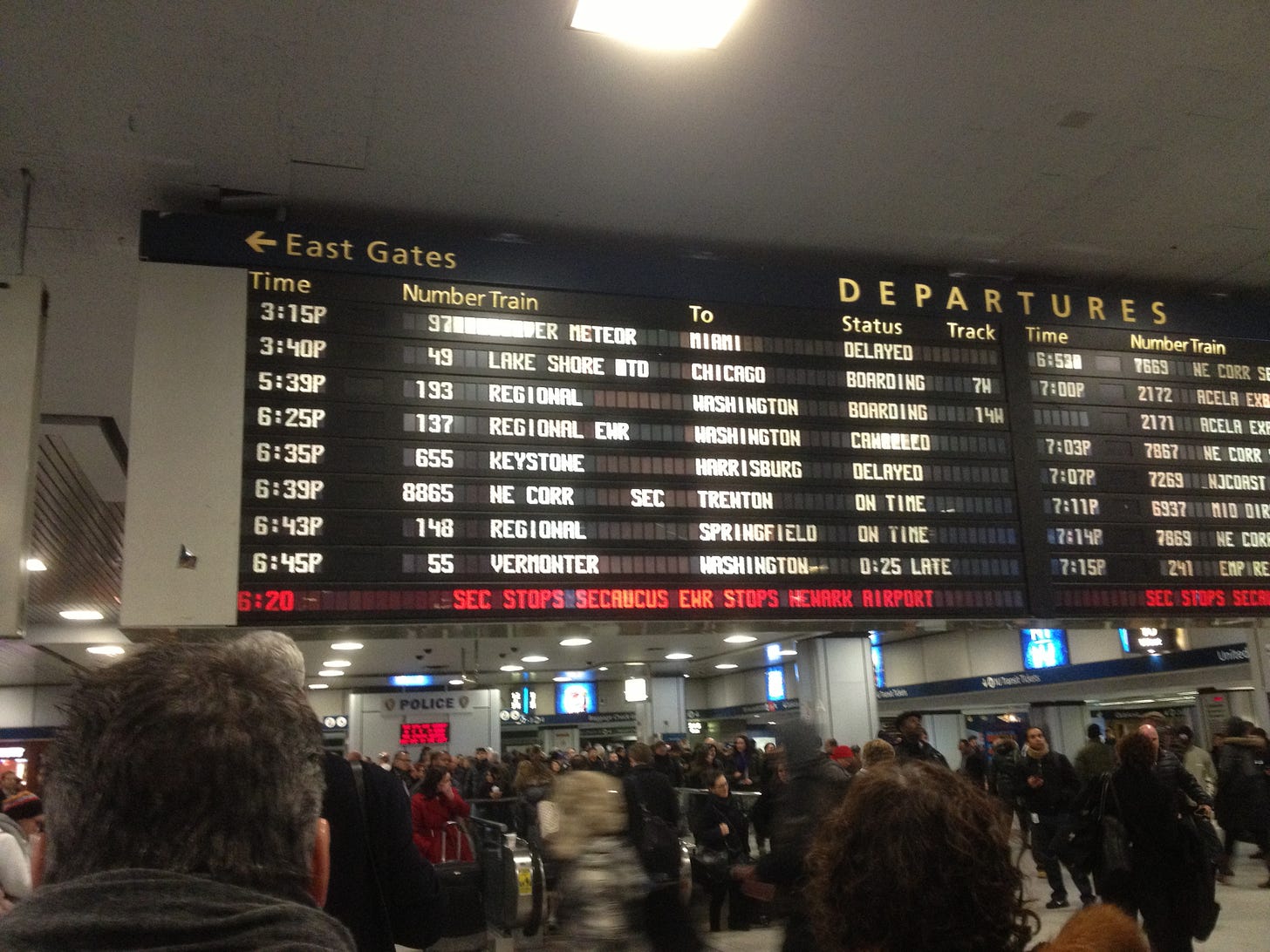Amtrak Back to Square One on Penn Station Expansion
Consultant Finds Fatal Flaws in Four Alternatives to Enlarging Station’s Footprint

Penn Station New York is the busiest transportation hub in the western hemisphere. Around 600,000 persons use the station on a normal weekday. Most take the Long Island Rail Road, New York City subways, or both.
Amtrak, which owns the station, and NJ Transit, the other regional rail line using the station, want to double the number of their trains that stop there, from 24 an hour at peak hours to 48, adding 200,000 more passengers. There is just one problem: where to put them.
Through the Gateway Program, Amtrak is building two new tunnels under the Hudson River. They will augment the existing tubes, which were built by the Pennsylvania Railroad in the early 20th century and suffered severe damage from Hurricane Sandy in 2012. Due to its urgency, the project is fully funded and construction is under way.
Once the new tunnels are complete they will be placed in service so that the original ones can be taken off line for rehabilitation. The project, which has a $16.1 billion price tag, is scheduled for completion in 2035. When it is finished, Amtrak and NJ Transit will have four tracks under the Hudson River at their disposal.
The bottom line is increasing Penn Station’s capacity will require expanding its footprint, whether to the south, as originally proposed, or to the north.
With twice the capacity, Amtrak and NJ Transit are planning to run twice as many trains between New York and New Jersey. To that end, when planning for Gateway began more than a decade ago it included an eight-track expansion of Penn Station to the south.
This would require properties to be acquired and demolished on the Midtown Manhattan block bounded by Seventh Avenue, 30th Street, Eighth Avenue, and 31st Street. The proposal is being opposed by neighborhood interests since it would displace many residents and small businesses. Consequently, it was pulled from Gateway and put on the back burner, so to speak.
Amtrak, NJ Transit, and Metropolitan Transportation Authority decided to investigate whether Penn Station’s capacity could be increased without expanding the station’s footprint. They retained WSP Global, a Canadian engineering and professional services firm, to study the issue and report back.
Last week, the findings of WSP’s report were shared with the media at a press briefing in New York. The firm concluded none of the four alternatives they evaluated would be feasible. All had fatal flaws of one form or another.
Two of the alternatives investigated called for building additional tracks beneath the existing station. The other two would implement through running schemes with Long Island Rail Road trains continuing on to cover NJ Transit routes and vice versa.
ReThink Penn Station NYC, a through-running proposal created by ReThinkNYC, a consortium of architects, urban designers and planners, offered what I thought would be an elegant solution: Rebuild Penn Station with fewer tracks and wider platforms where trains would unload and local passengers within a few minutes and continue on to their next step like subway trains do. The railroads would use directional running with all eastbound tracks on one side of the station and all westbound tracks on the other.
However, WSP concluded the scheme could only accommodate 40 trains an hour, not the required 48, and that reconstruction of the tracks and platforms would be too disruptive to station operations. The consultants said expanding under the station, which MTA did with Grand Central Madison, would not be feasible at Penn Station.
The bottom line is increasing Penn Station’s capacity will require expanding its footprint, whether to the south, as originally proposed, or to the north. Increasing capacity is a must. In a few years Metro North New Haven Line trains will be crossing the Hellgate Bridge to reach Penn Station. Amtrak wants to increase its frequencies and add services to Scranton and Allentown, PA, and Ronkonkoma, NY. NJ Transit wants to bring trains off its Raritan Valley and former Erie Railroad lines into Penn Station.
Then there is the matter of connecting the new tunnels to the existing station tracks. This will require new interlockings that will interface with existing track configurations. One of the headaches of operating a terminal station with bidirectional running is trains having to thread the complex web of switches and crossings between the station and the mainline.
This is a major source of bottlenecks. If, heaven forbid a train derails in one of the interlockings during rush hour the situation would quickly degrade into a potential disaster.
The railroads recognize they cannot shove an expansion plan down the public’s throat. They have committed to a “robust public engagement process” that includes an advisory group composed of more than 50 regional stakeholders .
The group, called SWAG (Station Working Advisory Committee), will meet regularly to discuss and provide input on both the Penn Station Expansion and Penn Station Reconstruction projects. The latter is being managed by the MTA and has its own schedule and funding.
Because of the complexity and cost of both projects I don’t expect construction to begin until the Gateway nears completion, sometime around 2035. In the meanwhile Penn Station, its railroads, passengers, and other stakeholders will continue to plod along.



